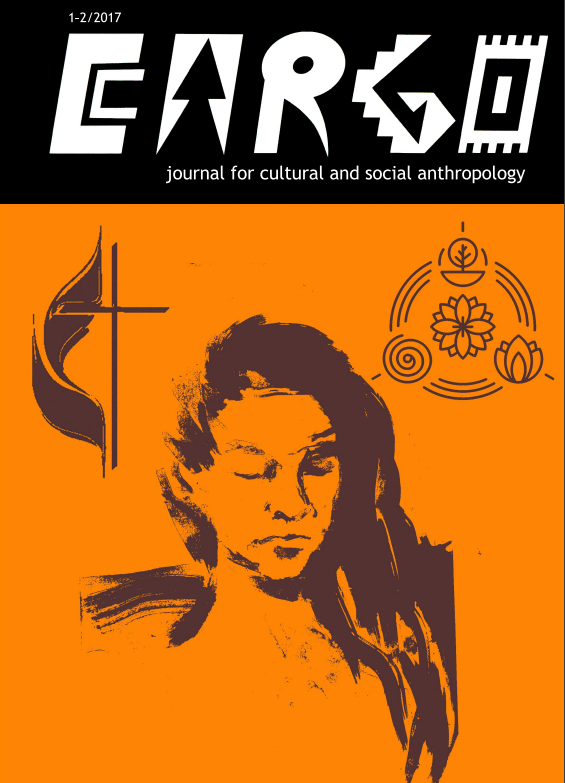Dělání ájurvédských těl
Keywords:
Ayurveda, CAM, awareness, articulation, control, technologies of the selfAbstract
In this paper, I discuss the practice of Ayurveda in the Czech Republic. Building upon ethnographic data acquired during participant observations and semi-structured interviews with Ayurveda students I examine and question non-curative effects of Ayurveda practice. I argue that Ayurveda changes self-understanding and everyday life of people who practice it. Moreover, these changes may persist even after the health issue disappear. Following the practitioners’ reflections on how Ayurveda has influenced their life, I look at new ways of perceiving, experiencing and handling their bodies. It has been argued that the practice of complementary and alternative medicine (CAM) brings both, bodily awareness and bodily mastery to people, which are perceived as beneficial. I explore how different ways of bodily awareness emerge through recognizing interconnections among different parts of the body (formerly perceived as quite independent) as well as among body and its surrounding socio-natural environment. I discuss how the newly emerged interconnections give an agency to formerly passive objects. More importantly I explore, how this holism of Ayurveda, this approach to body as a complex body-mind system, as a part of a wider socio-natural environment, affects the everyday practice of the people who attempt to live according to it. What kind of dilemmas do these new ways of enacting body produce? How the experience of the body which is strongly dependent dis/enable self-control?
References
Alter, Joseph S. 2005. Asian Medicine and Globalization. Philadelphia: University of Pennsylvania Press.
Baarts, Charlotte, a Inge Kryger Pedersen. 2009. „Derivative Benefits: Exploring the Body through Complementary and Alternative Medicine.“ Sociology of Health & Illness 31 (5): 719–733.
Beck, Ulrich, Anthony Giddens a Scott Lash. 1994. Reflexive Modernization: Politics, Tradition and Aesthetics in the Modern Social Order. Stanford: Stanford University Press.
Ellis, Carolyn. 2004. The Ethnographic I: A Methodological Novel about Autoethnography. Rowman Altamira.
Frank, Robert, a Gunnar Stollberg. 2002. „Ayurvedic Patients in Germany.“ Anthropology & Medicine 9 (3): 223–244.
Frank, Robert, a Gunnar Stollberg. 2004. „Conceptualizing Hybridization on the Diffusion of Asian Medical Knowledge to Germany.“ International Sociology 19 (1): 71–88.
Grünenberg, Kristina, et al. 2013. „Doing Wholeness, Producing Subjects: Kinesiological Sensemaking and Energetic Kinship.“ Body & Society 19 (4): 92–119.
Hsu, Elisabeth. 1999. The Transmission of Chinese Medicine. Cambridge: Cambridge University Press.
Hughes, Kate. 2015. „Anthony Giddens: The Reflexive Self and the Consumption of Alternative Medicine.“ In The Palgrave Handbook of Social Theory in Health, Illness and Medicine, ed. Fran Collyer, 439–454. Palgrave Macmillan.
Kessler,Christian,etal.2013.„Ayurveda:BetweenReligion,Spirituality,andMedicine.“ Evidence-Based Complementary and Alternative Medicine, Vol. 2013.
Klepal, Jaroslav, a Tereza Stöckelová. 2016. „(Post)socialistická zjednávání čínské medicíny.“ 18. pracovní konference Biografu, Rataje nad Sázavou, 17.–19. 6. 2016.
Křížová, Eva. 2015. Alternativní Medicína v České Republice. Praha: Karolinum.
Langford, Jean. 1995. „Ayurvedic Interiors: Person, Space, and Episteme in Three Medical Practices.“ Cultural Anthropology 10 (3): 330–366.
Latour, Bruno. 2004. „How to Talk about the Body? The Normative Dimension of Science Studies.“ Body & Society 10 (2–3): 205–229.
Mol, Annemarie, a John Law. 2003. „Vtělené jednání, zjednávaná těla: Příklad hypoglykémie.“ Biograf 31: 53 odst.
Mol, Annemarie, a John Law. 2004. „Embodied Action, Enacted Bodies: The Example of Hypoglycaemia.“ Body & Society 10 (2–3): 43–62.
Nissen, Nina. 2013. „Women’s Bodies and Women’s Lives in Western Herbal Medicine in the UK.“ Medical Anthropology 32 (1): 75–91.
Nordstrom, Carolyn R. 1989. „Ayurveda: A Multilectic Interpretation.“ Social Science & Medicine 28 (9): 963–970.
Rajpoot, Govind, Jan Šorf a Jan Vančura. 2016. Povědomí – Ájurvédská základní škola. Praha: Ájurvéda Kuti.
Reddy, Sita. 2002. „Asian Medicine in America: The Ayurvedic Case.“ The Annals of the American Academy of Political and Social Science 583 (1): 97–121.
Saks, Mike. 2008. „Plural Medicine and East-West Dialogue.“ In Modern and Global Ayurveda: Pluralism and Paradigms, eds. Dagmar Wujastyk a Frederick Smith, 29–42. Albany: State University of New York Press.
Sointu, Eeva. 2006. „Recognition and the Creation of Wellbeing.“ Sociology 40 (3): 493–510.
Stollberg, Gunnar. 2005. „Ayurvedic Medicine in Germany.“ http://www.unibielefeld.de/soz/pdf/PaperStollberg.pdf.
Viveiros de Castro, Eduardo. 2004. „Perspectival Anthropology and the Method of Controlled Equivocation.“ Tipití: Journal of the Society for the Anthropology of Lowland South America 2 (1): 1–20.
Vrzal, Miroslav. 2011. „Kritika konceptu New Age: New Age jako spiritualita, nebo lidové náboženství?“ Sacra 9: 54–64.
Waldram, James. 2000. „The Efficacy of Traditional Medicine: Current Theoretical and Methodological Issues.“ Medical Anthropology Quarterly 14: 603–625.
Warrier,Maya.2009.„Seekership,Spirituality and Self-Discovery: Ayurveda Trainees in Britain.“ Asian Medicine 4 (2): 423–451.
Warrier,Maya. 2011. „Modern Ayurveda in Transnational Context.“ Religion Compass 5 (3): 80–93.


